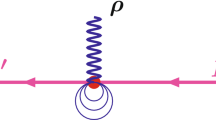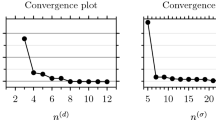Summary
The relativistic electron-pair model for the neutral pion developed earlier is extended to arrive at models for the charged mesons. The addition of a third electron or positron to the singlet state of the π0 system results in a charged particle of spin 1/2 whose mass and magnetic moment agree closely with the observed μ±-meson properties. A calculation of the lifetime against the emission of two quanta of spin 1/2 by the neutral core of this system, taking account of the relativistically increased mass of the radiating pair, leads to agreement with the observed μ-meson lifetime. The excited states of this system are found to be quantized in units of (ħ/2), and the first of these is found to fit the observed properties of the π±, including its mass, spin, and lifetime for decay to the μ± state with the emission of a spin-1/2 quantum or neutrino. The electromagnetic interaction between any two pions is examined and found to have the observed strength and short range of nuclear forces, independent of the charge state of the meson. By contrast, the interaction of muons with pions is shown not to lead to strong binding, thus accounting for the observed difference in the interaction of these two particles with matter. An examination of simple multi-pion systems leads to 2π, 3π and 4π molecular-type structures whose ground states reproduce the observed spins and masses of the K and η mesons, while the excited rotational states account for the known masses and angular momenta of all the pion-resonance systems observed so far.
Riassunto
Si estende il modello del pione neutro a coppia di elettroni relativistici, sviluppato in precedenza, in modo da giungere a modelli dei mesoni carichi. Con l’aggiunta di un terzo elettrone o positrone allo stato di singoletto del sistema del π0 si ottiene una particella carica di spin 1/2, la cui massa e il cui momento magnetico concordano strettamente con le proprietà osservate del mesone μ±. Un calcolo della vita media per l’emissione di due quanti di spin 1/2 da parte del centro neutro del sistema, tenendo conto del fatto che la massa della coppia irradiante cresce relativisticamente, porta ad un accordo con la vita media osservata del mesone μ. Si trova che gli stati eccitati di questo sistema sono quantizzati in unità di (ħ/2), e che il primo di questi risponde alle proprietà osservate del π±, compresa la massa, lo spin, la vita media per il decadimento nello stato μ± con l’emissione di un quanto di spin 1/2ħ o di un neutrino. Si esamina l’interazione elettromagnetica fra due pioni qualsiasi e si trova che ha l’intensità osservata e il breve raggio d’azione delle forze nucleari, indipendenti dallo stato di carica del mesone. Per contrasto, si mostra che l’interazione dei muoni coi pioni non porta a legami forti, rendendo così conto della differenza delle interazioni di queste due particelle colla materia. L’esame dei semplici sistemi multipionici porta a strutture 2π, 3π e 4π di tipo molecolare, i cui stati fondamentali riproducono gli spin e le masse osservate dei mesoni K ed η, mentre gli stati rotazionali eccitati rendono conto delle masse note e dei momenti angolari di tutti i sistemi di risonanza pionica sinora osservati.
Similar content being viewed by others
Literatur
Brief accounts of the basic ideas developed in the present paper were reported elsewhere:Bull. Am. Phys. Soc.,4, 228 (1959);5, 238 (1960);6, 257 (1961);8, 44 (1963);9, 116 (1964);Proc. Intern. Conf. on the Structure of the Nucleon (June 1963) edited byHofstadter andSchiff (Stanford, Cal.); p. 340.
E. J. Sternglass:Phys. Rev.,123, 391 (1961).
E. J. Sternglass:Proc. 1963Inter. Conf. on the Structure of the Nucleon; editors:R. Hofstadter andL. I. Schiff (Stanford, 1964).
M. H. Shwe: (Thesis, UCRL-10118, June 1962). The value determined experimentally was (2.0 +0.5−0.3 )·10−16 s; see alsoH. Shwe, F. M. Smith andW. H. Barkas:Phys. Rev.,125, 1024 (1962), where the lifetime is given as (1.9 +0.3−0.8 )·10−16 s.
If one doesnot take the kinetic energy associated with the precession into account explicitly and assumes that the proper frame of the system is at rest in the laboratory, one is led to the conclusion that an electron-pair system interacting by electromagnetic forces cannot have a mass in the laboratory greater than 2m 0 c 2 [seeA. Schild:Phys. Rev.,131, 2762 (1963)].
Both the relativistic Schrödinger and the Dirac equations lead to the occurrence of a term (Ze 2/ħc 2) in the centrifugal potential for a two-particle system. [See, for instance,L. I. Schiff:Quantum Mechanics, chapter XII (New York, 1949)].
E. A. Hylleraas:Norske Videnskaps Akad. Skrifter. Mat. Naturv. Kl.,6, (Oslo, 1932).
J. A. Wheeler:Ann. Acad. Sci. N. Y.,48, 219 (1946).
G. Feinberg andL. M. Lederman:Ann. Rev. Nucl. Sci.,13, 431 (1963).
J. D. Jackson: inClassical Electrodynamics, Sect.14. 2, eq. 14.24 (New York, 1962).
J. M. Blatt andV. F. Weisskopf: inTheoretical Nuclear Physics, chapter XII, Sect.6 a (New York, 1952), p. 623.
Reference (12), chapter XII, Sect.3.
W. H. Barkas andA. H. Rosenfeld: inData for Elementary Particle Physics (University of California, UCRL Report 8030, revised April 1963).
T. D. Lee andC. N. Yang:Phys. Rev.,105, 1671 (1957);L. Landau:Nucl. Phys.,3, 127 (1957);A. Salam:Nuovo Cimento,5, 299 (1957).
See the review article ofC. S. Wu: inTheoretical Physics in the Twentieth Century (New York, 1960), ed.M. Fierz andV. F. Weisskopf, p. 249.
The fact that failure of parity conservation cannot be concluded from the outcome of the Wu-Ambler experiment when charge is a pseudo-scalar andH is a polar vector in electromagnetic theory was discussed in detail byT.-Y. Wu:Am. Journ. Phys.,26, 568 (1958). This is equivalent to invariance under the combined operations of parity (P) and charge conjugation (C). It can be interpreted physically by saying that for the « shell-model electron » of finite size as required by a purely electromagnetic interpretation of the electron’s mass, the parity operation « turns an electron inside out », thereby reversing the direction of the lines of force at the shell surface and converting it into a positron.
A value ofg⋍2.2·10−49 erg·cm3 is cited byM. E. Rose in his review article, chapter IX, ofBeta- and Gamma-Ray Spectroscopy,K. Siegbahn, editor (New York, 1955), p. 287.
E. Fermi:Nuclear Theory, chapter IV, Sect.E (Chicago, 1950).
A. N. Soskovskij, P. E. Spivak, Yu. A. Prokofiev, I. E. Kutikov andYu. P. Dobrynin [quoted byM. Goldhaber:Proc. Inter. Conf. on High Energy Physics (CERN, 1958), p. 237].
O. Kistner andB. M. Rustad: [quoted byM. Goldhaber, ref. (21), p. 238].
B. W. Sargent:Proc. Roy. Soc. (London), A139, 659 (1933).
G. Danby, J. M. Gaillard, K. Goulianos, L. M. Lederman, N. B. Mistry M. Schwartz andJ. Steinberger:Proc. Inter. Conf. on High Energy Physics (CERN, 1962), p. 809.
H. B. G. Casimir andD. Polder:Phys. Rev.,73, 360 (1948).
See the interesting account of the historical development of ideas on the nature of short-range molecular forces byB. V. Derjaguin:Sci. Amer. (July 1960), p. 266.
E. Fermi:Nuclear Physics, chapter VII, (Chicago, 1950), p. 134.
See, for instance,D. Bohm, P. Hillion, T. Takabayasi andJ. P. Vigier:Prog. Theor. Phys. (Japan),23, 915 (1960);25, 901 (1961); alsoH. C. Corben:Proc. Nat. Acad. Sci. (USA),48, 1559 (1962).
J. J. Veillet, J. Hennessy, H. Bingham, N. Bloch, D. Drijard, A. Lagarrigue, P. Mittner, A. Roussft, G. Bellini, M. di Corato, E. Fiorini andP. Negri:Phys. Rev. Lett.,10, 29 (1963).
G. Feinberg andA. Pais:Phys. Rev. Lett.,8, 341 (1962).
K. W. Chen, A. A. Cone, J. R. Dunning jr.,G. N. Frank, N. F. Ramsey, J. K. Walker andR. Wilson:Phys. Rev. Lett.,11, 561 (1963).
R. P. Ely andD. H. Frisch:Phys. Rev. Lett.,3, 565 (1959).
R. F. Deery andS. H. Neddermeyer:Phys. Rev.,121, 1803 (1961);S. H. Neddermeyer, S. B. Curtis andP. Kotzer:Bull. Am. Phys. Soc.,7, 463 (1962);S. H. Neddermeyer:Proc. Inter. Conf. on the Structure of the Nucleon (Stanford, June, 1963, edited byHofstadter andSchiff, p. 393).
The empirical evidence for rigid-rotator type states of the heavy mesons and hyperons was pointed out in an early note before the present detailed models were developed [Bull. Am. Phys. Soc.,4, 228 (1959)]. Further empirical evidence suggesting a rigid rotator structure was discussed byR. D. Hill:Nuovo Cimento,23, 659 (1962). A short, summary of the present « molecular rotator model » for the pion resonances was presented elsewhere [Bull. Am. Phys. Soc.,8, 44 (1963)]. The fact that a number of the new unstable particles appear to fit rotational excited states of relativistic rotators according to a generalized field-theoretic model has also been pointed out byH. C. Corben: [Bull. Am. Phys. Soc.,9, 384 (1964)].
Author information
Authors and Affiliations
Rights and permissions
About this article
Cite this article
Sternglass, E.J. Electron-positron model for the charged mesons and pion resonances. Nuovo Cim 35, 227–260 (1965). https://doi.org/10.1007/BF02734836
Received:
Published:
Issue Date:
DOI: https://doi.org/10.1007/BF02734836




